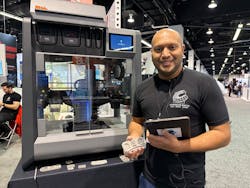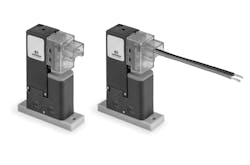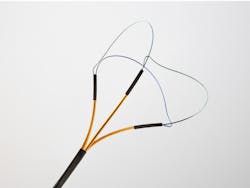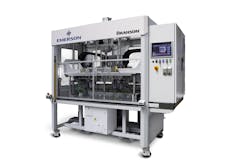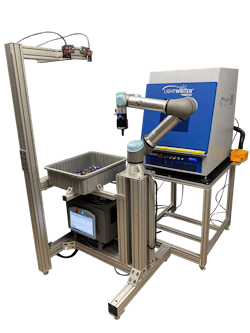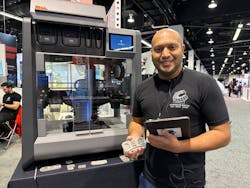Finger to the Wind: MD&M West 2023 Exhibitors Call the Trends
READ MORE: Autonomous Mobile Robot Lends a Hand to Manufacturing Facilities
The first rule of attending an industry trade show: One should arrive with a plan for navigating the show floor.
Attendees to Medical Design & Manufacturing West 2023, however, could add the caveat that pre-planning and best intentions to visit every hall likely would be overrun by unexpected opportunities and chance meetings.
The annual medical design and technology event (which took place Feb. 7-9) is co-located with four other advanced manufacturing events that bring together 1,600 suppliers and about 14,000 attendees. (The other four events are Design & Manufacturing West, Automation Technology West, Plastec West and WestPack.)
Unlike general attendees, exhibitors don’t have the luxury of holding a finger to the wind. Since they linger at their booths, they tend to have a unique vantage point from which to assess the overall event experience. They also arrive at the show with a unique set of goals.
An unscheduled stop at the Camozzi booth validated this idea. “Our goal is to get a feel for the industry, explore new opportunities where our products fit, and to continue building brand awareness around our product lines and our ability to provide custom solutions,” said Jo Solano, head of marketing for Camozzi’s USA office, who is tasked with looking for new marketing angles for the three Camozzi business channels of Life Science, Industrial Automation and Transportation.
Camozzi was a returning exhibitor and Solano said he had observed multiple companies returning for the 2023 show. “It was confirmation, in a way, that the medical trade show industry was returning to a sense of normalcy,” said Solano. “Attendees were very eager to mingle with suppliers and had very specific and sometimes super-technical questions regarding key components that they were needing to source for either new projects or projects currently in development.”
From where he stood, there are three trends stemming from this year’s event: getting back to a sense of normalcy; eagerness to resume in-person, meaningful conversations and catching up with colleagues; and growing 2023 business.
Attending and showcasing new product releases at tradeshows continues to be a critical part of the gameplan for the medical devices market. The tactic is especially true when companies want to expand their reach and strengthen their presence in a growing market. The global medical devices market is expected to be valued at $964.9 billion by 2030, according to one report.
Gauging this year’s show, collaboration with business partners is another strategy—whether it is for specific expertise, agility, time to market or to scale. Add to this the fact that brands can maintain an established identity while leveraging the technical developments of their partners (see for example the Apera.AI and Universal Robots collaboration below).
Solano pointed out that event organizers were already hosting registrations for the 2024 show, and the general feeling was that companies were looking to expand their booth space for 2024. “It will be interesting to see if the show hosts need to add more floorspace to accommodate all of the exhibitors,” he said.
What follows below is a mere sampling of products. Be sure to read our expanded coverage on MachineDesign.com and watch the videos associated with this year’s show.
Solenoid Valves Control Critical Fluids
Camozzi released its KDV series of valves, which features a compact, lightweight design with low power consumption and is an ideal solution for Life Science applications, such as mass spectrometry, liquid and gas chromatography and molecular analysis. Designed to protect controlled fluid from contamination, excessive temperature fluctuations and from interacting with the internal mechanical part of the valve, Series KDV can easily be integrated with manifold or subbase systems within small equipment and portable devices.
3D-Printed Charms Demonstrate Complex Geometries
Los Angeles-based 3DEO, one of the highest volume metal 3D printing companies with customers in the medical, industrial and aerospace industries, prioritizes design for additive manufacturing (DfAM). Recently, 3DEO added design and engineering services to offset its offerings, hoping to close the loop on end-to-end design and manufacturing services, with an ultimate goal of production at scale. 3DEO lured attendees to its booth in the MD&M West exhibit hall with “Call Me!” charms.
READ MORE: Robotics Trends to Expect in 2023
The miniatures are a tribute to Henry Dreyfuss’s Western Electric Model 500, an iconic classic of industrial design in mass production. According to 3DEO’s press materials, these tiny handsets demonstrate an ability to print highly complex, functional geometric features. The smooth inner channel of a constant cross-section is a nod to an ability to work “on ballnut ball return tubes in aerospace linear actuators and also trocar y-connectors for laparoscopic medical devices.”
Bringing Nitinol to the Table
Endosmart is a German manufacturer of medical devices and components made of nitinol, a metal alloy consisting of nickel titanium. The alloy’s unique properties—including superelasticity and “shape memory”—is undoubtedly a significant part of the motivation behind Alleima’s strategic acquisition of Endosmart in 2022. Formerly known as Sandvik Materials Technology, Alleima is known for advanced materials development and has more than 200 medical materials on offer. The acquisition of Endosmart would bolster its presence in the medical wire market. Fortunately, both companies have the shared goal to enable medical device users to live their day-to-day with minimal interruption.
During a lunch & learn presentation, colleagues from both sides shared why miniaturization of medical devices requires ultra-fine wire components. Using a material like nitinol helps them achieve precision cutting and wire grinding capabilities for such devices as pacemakers and hearing implants, but also wire-based components used for stimulation, sensing and transmitting signals.
Automation for Plastics Welding and Joining
At Emerson’s booth, the focus was on assembly, cleaning and fluid-control solutions. The automation solutions company showcased technologies that demonstrate its compliance with Medical Device Regulations (MDR). Emerson’s Branson range of welding equipment and automated solutions for plastics joining and mold cleaning boasts two laser plastic welding offerings, said Emerson’s Tom Hoover, senior key medical accounts manager, Americas, Branson Welding and Assembly.
READ MORE: Charge Up at MD&M West: What Happens at the MedTech Theater at the Same Time Everyday?
One branch focuses on product designers for product development and the other focuses on high-speed automation. “In automation, we take a laser diode energy and put it discretely around the part perimeter and match the part’s design...It’s a fast and efficient joining technology for plastics and has a cycle time of less than three seconds on most parts.” The GPX PulseStaking series is touted for giving OEMs greater design freedom by making it possible to join complex, delicate and sensitive components with embedded electronics to plastic moldings.
Ultra-Miniature, Programmable DC-DC Converters and Capacitor Chargers
For show and tell, Denver-based Advanced Energy Industries, Inc. could share its newly released Advanced Energy UltraVolt AEQ series, a series of ultra-miniature isolated single and dual-output high voltage DC-DC converters, as well as the Excelsys FC1500, a fully integrated capacitor charger and multiple output power supply. With a supply up to 600 VDC at 0.5 W output power from an input voltage of +5 VDC, the AEQ series optimizes power conversion in a wide range of applications, from handheld and portable devices, ranging from silicon detectors and avalanche photo diodes to MEMS devices and ultrasonic transducers.
The FC1500 capacitor charger delivers 1,500 W of constant power over all charge voltages from 200 V to 1,000 V and enables faster charging of capacitors when used at lower voltages in mixed technology systems. This helps reduce treatment times, according to the company. Field-configurable outputs provide a “plug-and-play” approach to address specific application requirements. “By combining a capacitor charger, AC-DC power and intelligent control, the FC1500 offers new ways for medical OEMs to design their laser and IPL systems,” noted Conor Duffy, vice president of marketing, medical power products at Advanced Energy.
4D Vision for Robotics
At the Universal Robots booth, one cobot picked shiny sockets out of randomized, mixed bins. The task is a complex challenge for traditional robotic systems. “What is important to know about AI in the robotics space is that it’s changing the project model, especially when it comes to robotic vision,” touted Eric Petz, head of marketing at Apera AI. The company is a UR+ partner, which means it is part of the Universal Robots’ ecosystem of third-party solutions for UR’s collaborative robot (cobot) arms. Apera AI makes it possible to achieve a total vision cycle time of just 0.3 sec. (3 Hz). The cobot can pick clear and translucent objects—a former gap in vision system abilities.
The system can operate under ambient light so that no specialized cameras, lighting or lasers are needed. The vision technology is also equipped for high-mix manufacturing, as it can flexibly change between parts. “It’s all off-the-shelf gear,” pointed out Petz. “We make the software that makes the whole system really smart…The AI ensures nothing collides in the environment. So, it’s path planning, it’s grasp intelligence. It’s the move in and out, and then verifying that the parts have been put together correctly.”
Software and Design Aids
In the CAD/CAM/CAE and software department, Design for Manufacturing & Assembly solutions loomed large. Featured among exhibitors were Source Graphics, which represents such brands as Formlabs, Ultimaker, Hewlett Packard, Canon and Artec 3D; Theorem Solutions, which provides specialist tools for CAD Translation and full-scale immersive XR visualization and collaboration; and HCL America, Inc., whose DFMPro suite facilitates upstream manufacturability and supports areas of design that are difficult and expensive to produce.
Between 30-50% of product development time is spent on rework, according to HCL America, Inc.’s press notes. This adds costly engineering changes to later stages of the product lifecycle and unnecessary delays and cost overruns. DFMPro from HCL provides built-in checks for manufacturing processes like machining, sheet metal, casting, molding, assembly, additive manufacturing and tubing. The software integrates fully within Creo Parametric, NX and SOLIDWORKS, and supports other leading CAD platforms.
CAD/CAM Consulting Services Inc. sells Mastercam, a computer-aided manufacturing (CAM) software that’s compatible with most CNC machines. “You can design on it, build tools on it, or run simulations so that you don’t have a failure on your machine when you go to print your part,” explained Axel Fernandes, additive manufacturing solutions lead with CAD/CAM Consulting Services. The Southern Calif.-based consultancy is able match the right solution with customers’ portfolios, Fernandes said during a booth demo of a Desktop Metal Studio 3D printer.
About the Author

Rehana Begg
Editor-in-Chief, Machine Design
As Machine Design’s content lead, Rehana Begg is tasked with elevating the voice of the design and multi-disciplinary engineer in the face of digital transformation and engineering innovation. Begg has more than 24 years of editorial experience and has spent the past decade in the trenches of industrial manufacturing, focusing on new technologies, manufacturing innovation and business. Her B2B career has taken her from corporate boardrooms to plant floors and underground mining stopes, covering everything from automation & IIoT, robotics, mechanical design and additive manufacturing to plant operations, maintenance, reliability and continuous improvement. Begg holds an MBA, a Master of Journalism degree, and a BA (Hons.) in Political Science. She is committed to lifelong learning and feeds her passion for innovation in publishing, transparent science and clear communication by attending relevant conferences and seminars/workshops.
Follow Rehana Begg via the following social media handles:
X: @rehanabegg
LinkedIn: @rehanabegg and @MachineDesign
